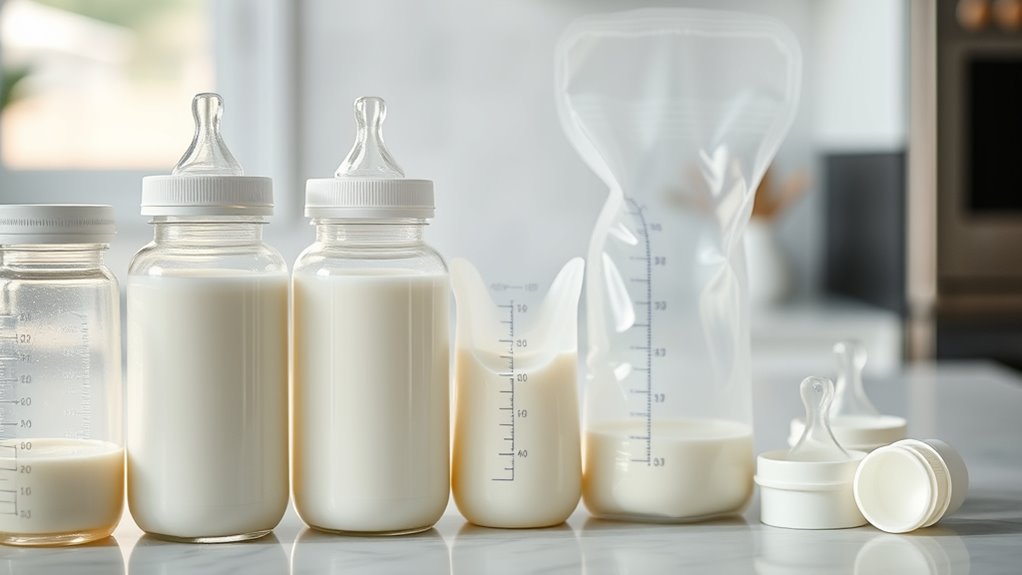When storing breast milk, choose clean, sterilized containers like BPA-free bottles or storage bags. Bottles are reusable and convenient for quick feeds, while bags save space and are better for freezing larger amounts. Label each container with the date to guarantee freshness and follow safety guidelines: refrigerate within four hours, use refrigerated milk within four days, and freeze for up to six months. Paying attention to proper storage techniques and hygiene can make a big difference—discover more to keep your milk safe and nutritious.
Key Takeaways
- Use sterilized, BPA-free bottles or storage bags to ensure safety and prevent contamination.
- Label containers with date and time to prioritize the oldest milk for use first.
- Refrigerate milk within four hours and consume within four days for freshness; freeze for longer storage.
- Avoid microwaving breast milk; instead, warm it in a water bath or refrigerator to preserve nutrients.
- Properly clean and sterilize storage containers regularly to maintain hygiene and prevent bacterial growth.

Have you ever wondered how to safely store breast milk to guarantee your baby receives its full nutritional benefits? Proper storage is vital, especially if you’re balancing breastfeeding techniques with a busy schedule. First, it’s important to understand that freshly expressed breast milk should be stored in clean, sterilized containers—either BPA-free bottles or specially designed breast milk storage bags. These options are convenient and help prevent contamination. When choosing between bags and bottles, consider your lifestyle. Bottles are reusable, easy to clean, and allow for quick feeding, while storage bags take up less space and are great for freezing larger quantities. Always label each container with the date the milk was expressed so you can use the oldest milk first, reducing waste and guaranteeing freshness. Additionally, necessary cookies ensure that your storage preferences and site settings are remembered, making future storage planning easier.
To guarantee your baby receives the full nutritional benefits of breast milk, proper storage techniques are vital. After expressing milk, let it cool to room temperature if needed, then promptly refrigerate or freeze it. The CDC recommends refrigerating milk within four hours of expression and consuming refrigerated milk within four days. If freezing, use the milk within six months for the best quality, although it remains safe for up to 12 months. When thawing frozen milk, do so in the refrigerator or by placing the container in warm water. Never microwave breast milk, as it can create hot spots and degrade some nutrients. Always swirl the milk gently before feeding to mix the fat layers evenly.
If you’re unsure about the best storage practices or want to maximize your pumping routine, consulting a lactation consultation can be incredibly helpful. A lactation expert can guide you through proper breastfeeding techniques, ensuring that you express milk efficiently and comfortably. They can also advise on storage methods tailored to your needs, helping you develop a plan that fits your schedule and minimizes waste. Remember, maintaining hygiene during storage is key—wash your hands thoroughly before expressing or handling milk, and sterilize bottles and bags regularly. Proper cleaning and storage not only preserve the milk’s nutrients but also protect your baby from bacteria.
Frequently Asked Questions
How Long Can Breast Milk Be Stored at Room Temperature?
You can store breast milk at room temperature for up to 4 hours, but beyond that, there’s a risk of breast milk spoilage. To guarantee safety, follow storage temperature guidelines, keeping it ideally below 77°F (25°C). After 4 hours, bacteria can grow, so it’s best to refrigerate or freeze the milk promptly. Always check for signs of spoilage before feeding your baby to keep them safe.
Are There Reusable Breast Milk Storage Options?
Yes, you can opt for reusable breast milk storage options that are both practical and eco-friendly. Reusable storage containers are designed to keep your milk fresh while reducing waste, making them a smart choice for environmentally conscious moms. These eco-friendly containers are durable, safe, and easy to clean, giving you peace of mind. With reusable storage, you’re not just saving money—you’re also making a positive impact on the planet.
How Do I Properly Label Stored Breast Milk?
To properly label stored breast milk, you should use clear labeling techniques like waterproof markers or labels designed for refrigeration. Follow storage labeling guidelines by including the date and time you expressed the milk, so you use the oldest milk first. Make sure labels are securely attached and visible. This helps guarantee freshness, safety, and easy identification, making your storage process organized and stress-free.
Can I Mix Freshly Expressed Milk With Previously Stored Milk?
Imagine pouring fresh, cool milk into a jar already filled with stored milk; yes, you can mix freshly expressed milk with previously stored milk. Just follow storage guidelines to guarantee safety. Always add the newest milk to the back of the container, so older milk stays at the front. This method keeps your milk fresh and reduces contamination risks, making sure your baby gets the safest, most nutritious feed possible.
What Are the Signs of Spoiled Breast Milk?
You’ll know your breast milk has spoiled if it smells sour or rancid, looks curdled or discolored, or has an unusual texture. Breast milk spoilage occurs when storage temperature guidelines aren’t followed—you should keep it refrigerated at 4°C (39°F) or colder, and use frozen within recommended timeframes. Always check for off smells and visual changes before feeding, and discard any milk that seems suspicious.
Conclusion
Remember, safety is key when storing breast milk—choose the right containers, label them clearly, and follow storage guidelines. Whether you opt for bags or bottles, always prioritize cleanliness and proper handling. As the saying goes, “A stitch in time saves nine,” so taking these simple steps now can save you from future worries. Trust your instincts, stay informed, and you’ll give your little one the best, freshest milk every time.









